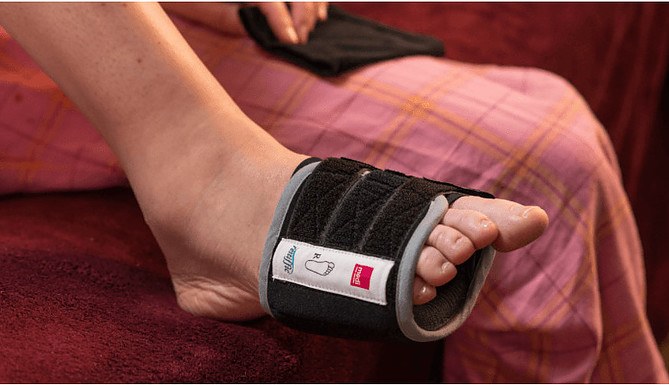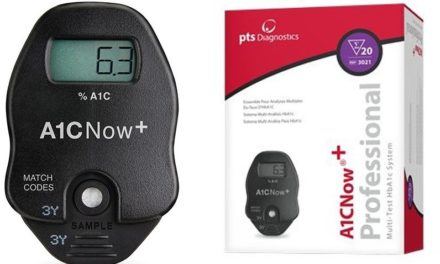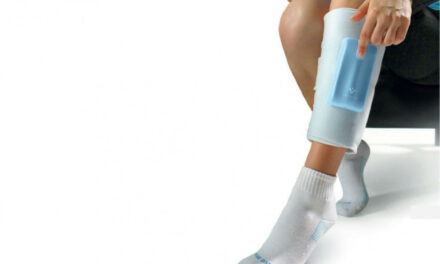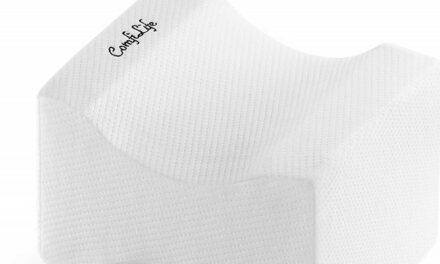Here we look at restiffic Foot Wrap and many questions you may be asking yourself about it. Most importantly, this restiffic Foot Wrap Review answers the question Can restiffic Help Restless Leg Syndrome (RLS)? Can You Use restiffic If You Have Diabetes? Can You Use restiffic If You Have High Blood Pressure? And many more…
Let’s look at a most likely scenario…
Picture bedtime and you are about to turn in for a good night’s sleep. But, just as you start catching some Zs, you are awakened by a very unpleasant tingling and an overbearing impulse to move your legs.
These sensations are so strong, so irritating, and so unbearable that you just have to pick yourself up and walk around till these uncomfortable feelings are gone.
Today, millions of people across North America and Europe are experiencing these odd sensations in their daily lives, indicating symptoms of a medical disorder known as restless leg syndrome
or simply RLS.
Unfortunately, RLS symptoms worsen with age especially, among women, and even more so for those with underlying associated health issues such as type 2 diabetes.
Some patients may be able to endure RLS symptoms, but for others, it may not be the case. Some of its devastating effects on the quality of life include:
- Chronic lack of sleep
- Depression
- Fatigue
- Impaired memory and even
- Hypertension.
It can be frustrating, when you sit to work or make out time to relax, watch TV, and/or read a book, only to experience unpleasant discomfort from RLS symptoms.
Prescription medications used over the years to treat RLS symptoms include – Dopaminergic drugs, benzodiazepines, and opioids. Unfortunately, these drugs often cause side effects and other issues such as the risk of dependence and misuse.
It wasn’t until recently that healthier treatment alternatives for relieving RLS symptoms emerged. We will be discussing restiffic RLS foot wrap here, as noted above, one of the best drug-free therapy options approved by the FDA.
What is resitiffic Foot Wrap?
restiffic RLS foot wrap is made of a compression pad plus a hook and loop system, designed to specially apply a form of acupressure on certain points beneath your foot. The soothing gentle pressure exerted by the foot wrap sends a message to your brain, which signals your muscles to relax.
Since its debut in 2016, restiffic has been a game-changing solution for people suffering moderate to severe restless leg syndrome. The foot wrap is an amazing new alternative for patients who have had no luck with medicated treatments or require a little bit of extra support.
How Did restiffic Start?
Mary Sorg, the inventor of restiffic had suffered restless leg syndrome for more than 30 years. Apart from the symptoms of RLS Mary had to bear, she was unable to get a good night’s sleep.
One night, unable to sleep till 2am, she simply felt so frustrated and so fatigued. Still, she somehow discovered that by applying a certain amount of pressure to the muscles beneath her feet, she was able to sleep.
She soon started trying out a combination of things to get the right pressure on those muscles, and that was it. It worked for her.
Her RLS symptoms were curbed, and her leg muscles seemed to relax.
The same idea worked for her family and the people around her, so Mary thought it would be a great help to many other people suffering RLS and decided to get it patented.
Here is the step by step information to guide you on restiffic RLS foot wrap.
What’s Included In restiffic Kit?
The restiffic RLS foot wrap kit contains:
- A pair of foot wraps labelled right and left
- A pair of Flexor-T pads also labelled right and left
- An identical pair of cover-ups
- A restiffic care bag
How To Use restiffic?
- Flexor-T pads should be placed in the pocket of foot wrap first before application
- While seated, place foot wrap flat on the floor.
The label should be visible and oriented correctly, so you can easily read it.
- Identify the ball of your foot just below your big toe, which will be the landmark for correctly placing your foot on the Flexor-T pad.
- Slide your foot into the pocket of the foot wrap.
Ensure the ball of your foot is placed in the divide of the Flexor-T pad, and your toes exposed at the end of the wrap.
- Loop the straps through the hook and loop.
Adjust the straps until it is firm but comfortable.
Note: correct pressure is crucial to the therapeutic effect of restiffic foot wrap.
- Slide a cover-up over the foot wrap to prevent the strap material from snagging on clothes or materials.
- Repeat the same steps for the second foot.
Features of resitiffic Foot Wrap
- Cleared for prescription by the U. S. Food and Drug Administration (FDA) as Class 1 device, to determine positive RLS diagnosis.
- Drug-free treatment with zero risk of addiction and lower risk of side effects.
- Easily adjustable hook and loop material to allow each wearer to instantly customize compression.
- Flexor-T pads laps the ball of the foot for a great fit.
- The application and removal process is simplified for easy nightly use.
- Light-weight and anatomic design ensure uninterrupted sleep and maximum comfort.
Pros
- You can easily apply or remove within minutes or follow the application video above for help.
- Available for sale in the United Kingdom, the United States and the Netherlands. And, restiffic product registration with several international healthcare agencies is ongoing, following their plans for expansion.
- Easily purchased online, pharmacies or online health stores for about $350 a pair.
- It comes in 3 different sizes to accommodate the smallest women size to the largest men size
- Restiffic has a 30-days guarantee, with a return and full refund policy if the purchase is considered unacceptable.
- There is also a 6-month workmanship warranty, provided your product is registered online. But it does not cover abnormal care and uses or normal wear and tear.
- If you don’t have a prescription, a restiffic customer representative can help you get one, or you can provide your physician with this custom prescription.
Cons
- You will be unable to purchase this product without a prescription, in some countries.
- The product may be considered expensive, but definitely worth the price for many.
- restiffic is not covered by Medicare, like many other medical out-patient devices.
- Some may find putting it on a little tricky at first, but with a little patience, you’ll get the hang of it.
- Some report feelings of pain or numbness after putting on restiffic. This can be resolved by loosening the straps and readjusting the straps’ compression.
Precautions
- Do not wear if you have fragile skin, wounds, sprains, cuts and the likes, involving your legs and/or feet.
- Do not use in water or when engaged in any activity that pressures the feet, such as driving, running or walking.
- If you are pregnant or have any chronic diseases, consult with your doctor first before using restiffic.
- Although clinical trials have been performed for restiffic foot wrap, there are no clinical studies on people taking RLS medications. Consult with your doctor before commencing treatment.
Possible Side Effects
- If the foot wrap is placed too tight on the feet, or applied while you are putting pressure on your feet, or using your feet, you may experience foot pain.
- On the other hand, if the foot wrap is positioned too loosely on the feet, it can unfasten and make you trip over when you try to walk or stand.
- A few other uncommon issues….
What Causes Restless Leg Syndrome (RLS)?
Primary RLS
As for what causes primary RLS, it is unknown. Then again, Neurologists believe the brain can send a wrong signal to the feet and back, due to a minor dopamine dysfunction, which can be a cause for RLS. It could also be hereditary or caused by iron deficiency.
Secondary RLS, however, usually affects adults over 40 years of age-associated with one or some of the following:
- Chronic conditions such as diabetes, kidney disease, peripheral neuropathy, Parkinson’s disease, iron deficiency
- Pregnancy
- Sleep deprivation or sleep apnea
- Varicose veins
- Caffeine, alcohol and nicotine
- And certain medications such as antidepressants, antipsychotic drugs, antinausea drugs, some allergy and cold drugs.
Secondary RLS
Secondary RLS may exhibit the same symptoms as primary RLS, but their treatment approach is not entirely the same. The focus when treating patients with secondary RLS, is aimed at the underlying cause along with certain medications and lifestyle changes. Therefore, eliminating or reducing these factors may relieve RLS symptoms.
Can restiffic Help Restless Leg Syndrome (RLS)?
restiffic foot wrap works for RLS by exerting pressure on 2 muscles in your foot – the flexor hallucis brevis and the abductor halluces. You may not be familiar with these muscles, but they are important muscle trigger points in our feet linked to the treatment of RLS symptoms.
Researchers believe that applying pressure on these muscles creates brain signals that relax the stimulated muscles in RLS cases.
Notable research and case studies have proven that restiffic foot wrap helps alleviate moderate to severe primary RLS symptoms, as well as improve the quality of sleep.
Several authors also conducted a pilot study to establish the effectiveness of restiffic foot wrap as published in The Journal of the American Osteopathic Association. The study revealed that the adjustable foot wrap significantly reduces symptoms of moderate to severe primary RLS by 1.4 times, and was 40% more effective compared to medication therapy.
It is true that medications can ease moderate to severe RLS symptoms. Still, those drugs often leave some severe side effects such as dizziness, nausea, vomiting and risk of addiction. This has caused a lot of people to abandon its use.
For people suffering from restless leg syndrome, the need to restore sleep and at the same time preventing the side effects of the medication is a major challenge says Dr. Rob Danoff, DO, an Osteopathic Practitioner. Fortunately, restiffic foot wrap resolves a huge portion of this issue.
Can You Use restiffic If You Have Diabetes?
Because people with diabetes usually have sensitive skin and nerves, treating their RLS symptoms with restiffic foot wrap is not advised. Do not use the device if you discover you have peripheral neuropathy, peripheral vascular disease, a history of leg/foot swelling, or blood clots.
Consult with your doctor first to make sure your medical condition won’t contraindicate your use of restiffic.
Restless leg syndrome is quite common among people with type 2 diabetics, who additionally may also suffer sleep disorders related to impaired glucose metabolism.
As we know it, unregulated high blood glucose levels can damage nerves in our extremities, leading to diabetic peripheral neuropathy – one of the common causes of secondary RLS.
Can You Use restiffic If You Have High Blood Pressure?
According to a research published by The Journal of American Heart Association, restless leg syndrome is a major risk factor for high blood pressure. Therefore treating RLS could have a positive beneficial effect on blood pressure and the risk of developing heart disease.
Additionally, WebMD reports that there is an increasing number of research linking RLS and other conditions affecting quality sleep with heart disease and stroke.
More importantly, restiffic foot wrap should never be used without a medical prescription. There is currently no clinical study available for RLS patients with high blood pressure, using restiffic foot wrap. You must refer to your doctor if you have high blood pressure and wish to try restiffic.
Conclusion
restiffic is appealing and extremely valuable, especially to those who find it difficult or wish to avoid taking standard drug medication. Clinical trials have proven its effectiveness in treating moderate to severe RLS symptoms.
Many users report immediate relief within minutes after putting on restiffic, and others notice gradual changes within the first few weeks.
Although there have been a few cases where people reported no changes in their condition after using restiffic, the positive testimonies of thousands of others outweigh them.
Nevertheless, restiffic is always a good and typically safe, RLS treatment alternative to consider. You can speak to your doctor about it. After putting your health conditions into consideration, it might be just what you need to calm those restless legs and get a good night’s sleep.
Finally, if the treatment result is unacceptable, you can be assured of restiffic’s money-back guarantee. If you wish to experience first-hand the amazing benefits of restiffic RLS foot wrap, don’t think twice about buying your own pair now.












